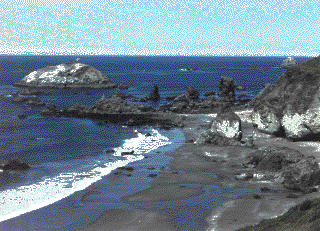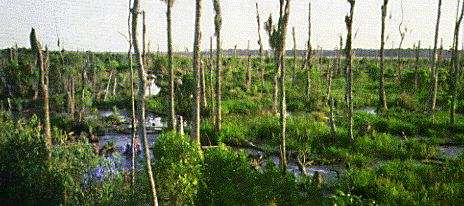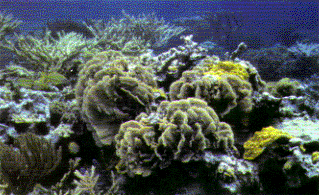Types of Coasts
Coasts are the dynamic junction of water, air, and land. Winds and waves, tides and currents, migrating sand dunes and mud flats, a variety of plant and animal life -- all combine to form our ever-changing coasts. Their dynamic nature results in their great diversity. Most of us envision a coast as a broad stretch of sand with frothy surf breaking along the shore; in fact, many types of coasts are found within the United States, ranging from sandy beaches to rocky shores to coral reefs to coastal wetlands.
Rocky Shores
 Rocky shores form on high-energy coasts where mountains meet the sea and at the base of sea cliffs. Active tectonic environments, such as in California, produce rocky coasts as a result of mountain-building processes, faulting, and earthquakes. Rocky coasts also form where ice and strong waves have effectively removed fine-grained sediment. In Maine and parts of Alaska, glaciers have scoured most of the sediment cover from the shore. In the arctic, ice gouging and rafting have removed sand-sized particles from some beaches, leaving cobbles and boulders.
Rocky shores form on high-energy coasts where mountains meet the sea and at the base of sea cliffs. Active tectonic environments, such as in California, produce rocky coasts as a result of mountain-building processes, faulting, and earthquakes. Rocky coasts also form where ice and strong waves have effectively removed fine-grained sediment. In Maine and parts of Alaska, glaciers have scoured most of the sediment cover from the shore. In the arctic, ice gouging and rafting have removed sand-sized particles from some beaches, leaving cobbles and boulders.
Sandy Beaches
 Sandy beaches can be categorized into three types: mainland, pocket, and barrier beaches. Mainland beaches stretch unbroken for many miles along the edges of major land masses. Some are low standing and prone to flooding; others are backed by steep headlands. They receive sediment from nearby rivers and eroding bluffs. Examples of mainland beaches include coasts of the Great Lakes, northern New Jersey, and southern California. Pocket beaches form in small bays surrounded by rocky cliffs or headlands. The headlands protect the sandy alcoves from erosion by winter storms and strong currents. Pocket beaches are common in New England and the Pacific Northwest. Barrier beaches are found along the Gulf of Mexico, the east coast, and much of Alaska. They are part of complex integrated systems of beaches, dunes, marshes, bays, tidal flats, and inlets. The barrier islands and beaches are constantly migrating, eroding, and building in response to natural processes and human activities.
Sandy beaches can be categorized into three types: mainland, pocket, and barrier beaches. Mainland beaches stretch unbroken for many miles along the edges of major land masses. Some are low standing and prone to flooding; others are backed by steep headlands. They receive sediment from nearby rivers and eroding bluffs. Examples of mainland beaches include coasts of the Great Lakes, northern New Jersey, and southern California. Pocket beaches form in small bays surrounded by rocky cliffs or headlands. The headlands protect the sandy alcoves from erosion by winter storms and strong currents. Pocket beaches are common in New England and the Pacific Northwest. Barrier beaches are found along the Gulf of Mexico, the east coast, and much of Alaska. They are part of complex integrated systems of beaches, dunes, marshes, bays, tidal flats, and inlets. The barrier islands and beaches are constantly migrating, eroding, and building in response to natural processes and human activities.
Coastal Focus: Hog Island, Virginia
Most of the Nation's coastal wetlands are in Louisiana, along the Mississippi River and its active and ancient deltas, and in Alaska, at the mouths of the Yukon and Kuskokwim Rivers. The Great Lakes and the southeastern seaboard are fringed by other important wetlands, such as Florida's Everglades. Coastal wetlands can be dominated by salt water, as along the gulf coast of Louisiana, or they can contain a complex and changing mixture of salt and fresh water, like the estuaries of the Chesapeake, Galveston, and San Francisco Bays.
Coastal Wetlands
 Coastal wetlands include swamps and tidal flats, coastal marshes, and bayous. They form in sheltered coastal environments often in conjunction with river deltas, barrier islands, and estuaries. They are rich in wildlife resources and provide nesting grounds and important stopovers for waterfowl and migratory birds as well as spawning areas and valuable habitats for commercial and recreational fish.
Coastal wetlands include swamps and tidal flats, coastal marshes, and bayous. They form in sheltered coastal environments often in conjunction with river deltas, barrier islands, and estuaries. They are rich in wildlife resources and provide nesting grounds and important stopovers for waterfowl and migratory birds as well as spawning areas and valuable habitats for commercial and recreational fish.
Coral Reefs
 Coral reefs abound along the southern coast of Florida and around the Hawaiian Islands, Puerto Rico, the Virgin Islands, and the Pacific Islands. In the shallow waters off tropical isles, living coral organisms build reefs that provide important wildlife habitats and protect coasts from waves and storms. Healthy coral reefs are also an important source of carbonate sediment for tropical beaches. Raised coral platforms no longer inhabited by living coral provide coastal materials and form islands such as the Florida Keys.
Coral reefs abound along the southern coast of Florida and around the Hawaiian Islands, Puerto Rico, the Virgin Islands, and the Pacific Islands. In the shallow waters off tropical isles, living coral organisms build reefs that provide important wildlife habitats and protect coasts from waves and storms. Healthy coral reefs are also an important source of carbonate sediment for tropical beaches. Raised coral platforms no longer inhabited by living coral provide coastal materials and form islands such as the Florida Keys.
